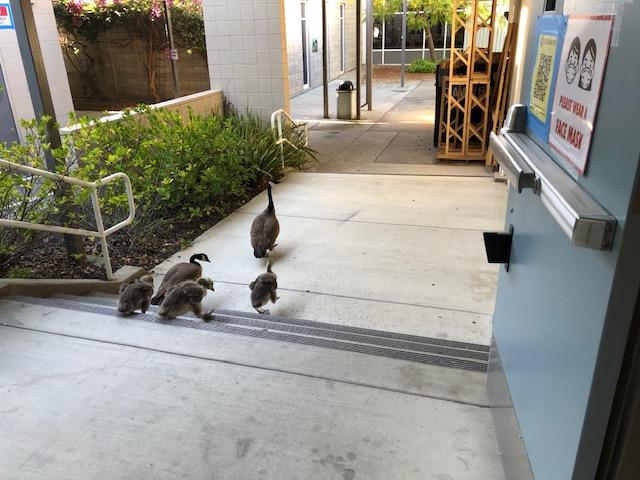In his day-to-day work, maintenance supervisor Paul Weir sees a variety of animals around campus. He recalls that when school was remote during the 2020-2021 school year, he would routinely notice a coyote on the baseball field.
Weir is not alone in observing wildlife that inhabit or intrude on the school’s 40 acres. Alongside other staff members, he has taken note of the habits of birds, rabbits and other species that live in the school’s rooftops and bushes. Large tree canopies between hallways provide a convenient bridge for raccoons and mice when they are overgrown, and the campus has served as a home for Canadian Geese, crows and even a group of swallows and falcons that nested above the Multimedia building and on the roof.
“Because the birds are migratory, I want to knock down the [nests] and clean the area before the swallows come back,” Weir said. “We try and discourage them from building nests, but once they’re breeding and there are eggs or chicks, we leave them alone.”
Weir recalls seeing a family of Canadian Geese last year that nested above the administration building and frequently walked the building’s roofs. When the geese chicks grew old enough, they left their rooftop nest to wander the school’s hallways.
There were at least two geese families that would walk the school, unbothered by students, Weir said.
Other staff members report similar wildlife sightings, particularly during the year of online learning during the pandemic. Math teacher Audrey Warmuth, who visited campus during remote learning, noticed a greater animal presence when the school was devoid of students.
“The campus had a really different ‘feel’ because there was hardly anyone here,” Warmuth said. “One of the few positives was that there seemed to be more birds. These geese must have had a nest on campus or close to campus because I saw them often. Seeing them always brightened my day.”
The Canadian Geese on campus have attracted so much attention from students that an Instagram account @georgetgoose was created last year to document the geese’s journeys.
Additionally, throughout the years, students sitting in the quad have been subjected to seagull poop if they were sitting in the wrong place at the wrong time, journalism adviser Michael Tyler said.
Other prominent birds on campus include a large population of crows, which school resource aide Raquel Kirby described as being especially “smart and crafty.” Kirby also remembers seeing a bird flying around in the The Learning Center last spring as well as a brown bunny by former athletic director Tim Lugo’s office in 2021, which she crossed paths with on a walk back from the track.
College and Career Center (CCC) Specialist Brad Ward recalls chasing out a crow that had walked several feet into the CCC building when she left the doors wide open.
“The crows on this campus are nuts,” Ward said. “Just watch the trees by the quad towards the end of lunch, and then when the bell rings and students begin to return to campus, how like 100 of them swoop down to scavenge anything.”
In addition to crows, the area around the CCC is home to hummingbirds on both the front and back sides of the building with a reptile habitat in the rocky area on the side by the music building, she said. Other small birds sometimes try to nest on the CCC’s roof overhang and fly into the CCC’s windows, which Ward has tried to prevent by papering her windows with flyers.
Other miscellaneous animals on campus, according to assistant principal Matt Torrens, include rabbits living in the bushes by the gym and dance studio, raccoons that scamper onto the roof in the math quad and gopher snakes that leave behind their skins in various places around campus. Torrens has heard reports of bald eagles and golden eagles flying overhead, alongside deer which come up from the creek to approach campus.
English teacher Meg Battey has seen skunks roaming the hallways early in the morning, and squirrels frequently jumping from tree to tree. A small lizard also visited math teacher Lisa Ginestet-Araki’s room a couple of times this year, leading to her stopping class to catch it with her students and put it back outside.
Frequent sightings of birds and other wildlife have piqued the interest of staff members such as administrative assistant Alison Montgomery, who enjoys watching and interacting with the colony of crows, chestnut-backed chickadees and a pair of mated ravens that live on campus.
“The mated ravens are just as intelligent [as crows], and if you actually watch them fly, they can do more acrobatics in the air, so they’re very cool to watch,” she said.
Montgomery has also helped rescue injured birds at school, which she then sends to the Wildlife Center of Silicon Valley, located by Alum Rock Park in San Jose, for rehabilitation. Once, when assistant principal Brian Thompson noticed an injured crow fluttering in the parking lot, Montgomery was able to catch the bird using a blanket that she keeps in the back of her car and later sent it to the rehabilitation center.
She also recalls that when a student from a few years ago brought in a baby hummingbird, office staff and current sophomore Jay Louie helped look after the bird until it recovered.
“I like animals, so I do a lot of research on animals when I see them — we’re all about the birds in this office,” Montgomery said. “Every day when I come to work, I just look at the birds and I’m fascinated by them.”


























